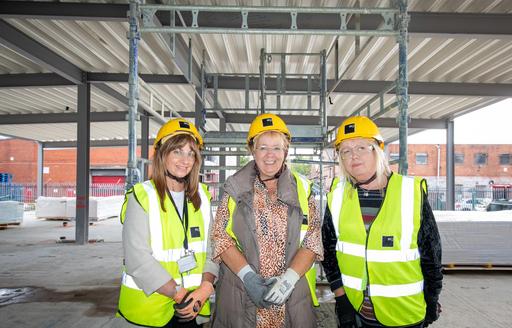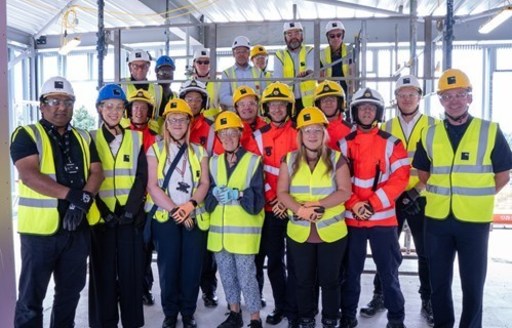Sustainable Buildings Monitor: Redefining value - a public sector perspective - event review

The expert panel explored how the sector can benefit from a sustainable framework, which demonstrates the growing impact of the environmental, social and governance or ESG agenda.
ISG brought together guests from the public sector and strategic private sector partners, that collaborate closely with local and national government bodies. The panellists were from Alliance Leisure, AECOM, NHS England, Welsh Government and the Defence Infrastructure Organisation. Chaired by Colin Hamilton, Sector Director for Health at ISG, with contributions from Ross Wood, Group Head of Sustainability at ISG, the panel attracted an online audience of leaders, experts and specialists from across the public sector and construction industry.
Ross Wood provided an introduction to ISG’s latest research on redefining value, with a focus on the public sector perspective, “We believe that there is a different way of defining value in the built environment that can benefit all. Our new report seeks to change how we visualise economic growth and opportunity across the UK, and for the public sector, it’s about recognising the impact of policy decisions and learning from similar regional experiences.”
ISG’s framework seeks to create a more holistic view of valuation and includes operational performance data, net zero carbon information, social value, circulatory measures and proximity metrics to green energy sources and local labour markets. The index is organised into three pillars: environmental and social factors, people and workforce factors, and traditional financial and commercial factors. The results from these holistic metrics show a map of untapped opportunity across communities the length and breadth of the UK.
Helen Sturdy, Head of ProCure23 Framework and Construction Lead for NHS England, spoke of tackling regional issues by working with other government departments and joining up the public and private sectors, to share resources and knowledge to address each local and regional area appropriately. She also spoke about how assets can work harder for local communities.
Building on this narrative, Neal O’Leary, Welsh Government Programme Director – Sustainable Communities for Learning, spoke about the Welsh approach on what an asset can deliver for the community. He said, “The Welsh Government has committed to undertaking a review of how we use our schools and education spaces - potentially looking at schools more holistically as assets and how they might provide additional support to their community.”
Thinking about outcomes that the public and private sectors want from projects, Miriam Ozanne, Regional Director for Building Engineering at AECOM, commented, “Having this framework at the early investment appraisal stage is brilliant, and helps give a language and a metric to the key issues and ESG considerations that we are trying to bring upfront to the beginning of a project.”
James Foley, Commercial Director for Alliance Leisure, spoke about the opportunities for the framework to inform infrastructure decisions on a wider geographical basis. James said, “The framework can help deliver against health inequality challenges, looking through the lens of asset planning.” He stressed that local authorities can use the monitor approach and the specific data to look at the environment from a broader geographical basis, to inform asset planning decisions and provide benefits in addressing health inequalities.
David Salmond, Director for Major Programmes and Projects for the Defence Infrastructure Organisation (DIO), said, “The report has really challenged me to think about application with the defence estates, and what the results are saying is highly consistent with our existing policy and practice.”
Reviewing the data, James Foley referenced the Construction Playbook in terms of a wider definition of value, and linking this to a need to incentivise against the three pillars in the report as a total balanced approach to procurement, helping to address punitive measures on social value in project contracts.
Helen Sturdy spoke about how she is always looking at value and using working groups with ISG and other contractors to evaluate how we innovate and do things differently to ensure the right questions are being asked around focus areas, such as social value, when procuring capital projects.
In terms of co-location community opportunities, Helen Sturdy spoke to re-purposing the high street driven by individual community need. Helen noted that we must continue to invest in hospital infrastructure, but moving other services into the community will ease the pressure on acute care, creating hubs that are easily accessible and co-located with complementary facilities and services, such as wellbeing and leisure.
Speaking from a Welsh Government perspective, Neal O’Leary alluded to the Sustainable Communities for Learning Programme. This, he observed, reflects the important community value of the Welsh Educational Estate, in areas such as health support, wrap around facilities and supported learning across one location. He said, “This report can help local authorities and further education delivery partners in translating the Welsh Government’s ambition out there on the ground.”
On generating better use from existing buildings, Miriam Ozanne reflected the importance of the report’s holistic approach to maximise value from available resources. She commented on the potential benefits from an environmental perspective and the opportunities to make buildings more easily adaptable when considering co-location, adding “It's the interconnectedness of all of these factors that feature in this holistic measure that makes it so useful. It’s about how can we get the best from our buildings and not double up and create space where it's not needed.”
David Salmond agreed that there is a duty of care around the disposal of government buildings and land to inform future use for wider community benefits. He said, “There is an opportunity to use the data from the report to inform how our programmes and projects make a more targeted contribution to local needs, for example future skills requirements. There is also potentially a further opportunity for a more joined-up approach by local authorities creating strategies and policies led by the framework.”
From an NHS perspective, Helen Sturdy spoke of the disposal of buildings to invest in new facilities, and the consideration to allow for biodiversity in this new building approach. When looking at the NHS refurbishment programme, Helen spoke of the existing estate and planned upgrades, taking into account the lower embedded carbon commitment, and ensuring buildings can flex and adapt for future healthcare demands.
Discussing best practice, James Foley spoke of the requirement for appropriate data sets to benchmark effectively being the key to helping inform asset strategies. James remarked that true benchmarking on a wider definition of value will help facilitate sharing of best practice. Ross Wood agreed that there needs to be common language and conversations between private and public sectors to facilitate collaboration across sectors.
In summary, Colin Hamilton recognised the common threads around collaboration and partnership between public and private sectors in maximising the wider value of property assets. For some, the research provided validation for existing approaches, for others it’s holistic focus presented opportunities for further discussions with partners to unlock value and drive investment. What is clearly evident is the appetite and ambition from all participants to look beyond traditional evaluation measures and embrace an ESG-focused framework for asset master planning.
You can watch the webinar highlights and download a copy of the report here.


